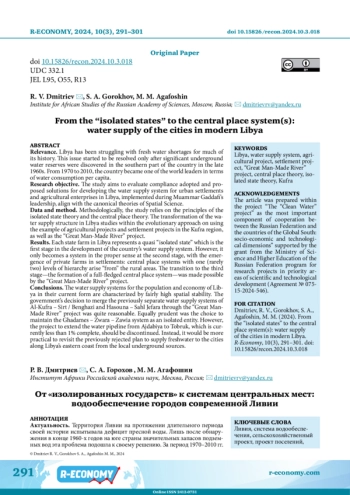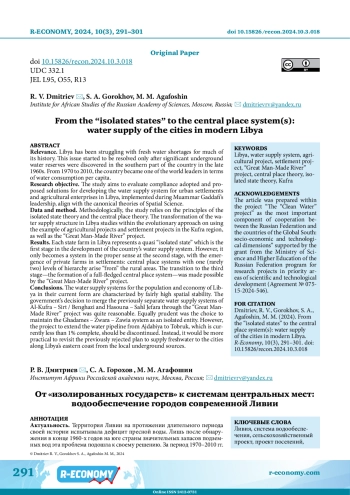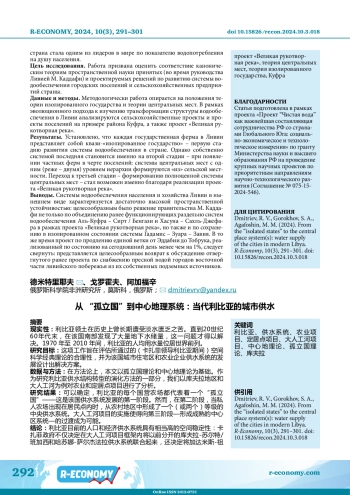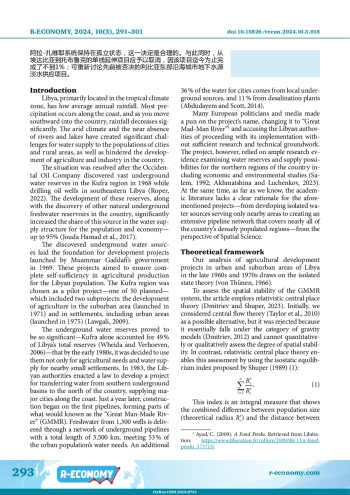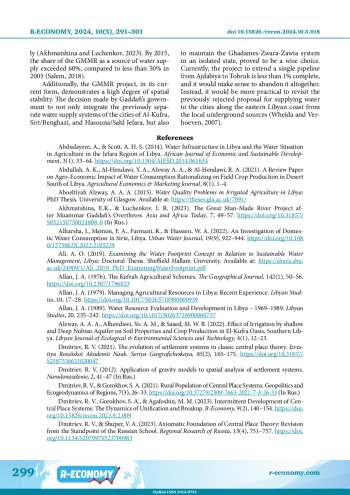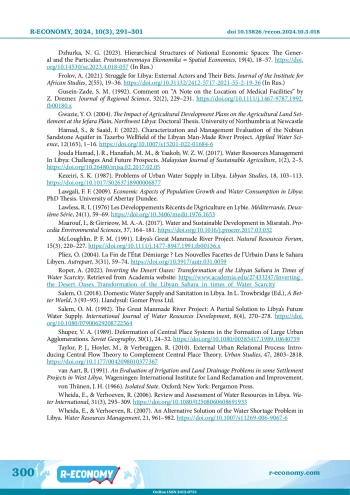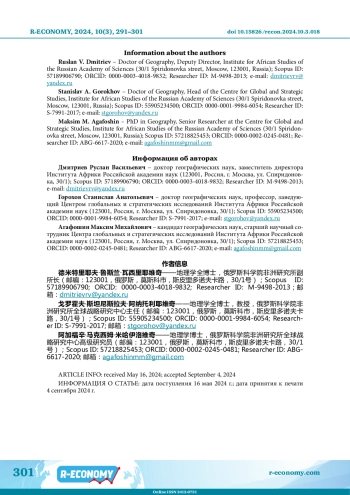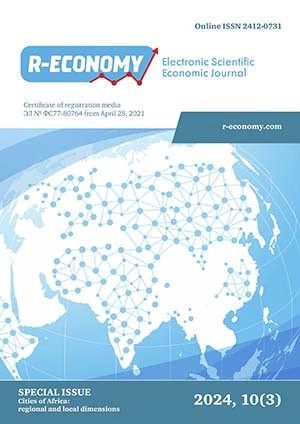1. Abdudayem A., Scott A. H. S. (2014). Water Infrastructure in Libya and the Water Situation in Agriculture in the Jefara Region of Libya. African Journal of Economic and Sustainable Development, 3(1), 33-64. DOI: 10.1504/AJESD.2014.061634
2. Abdullah A. K., Al-Hendawi Y. A., Alzway A. A., Al-Hendawi R. A. (2021). A Review Paper on Agro-Economic Impact of Water Consumption Rationalizing on Field Crop Production in Desert South of Libya. Agricultural Economics & Marketing Journal, 8(1), 1-4.
3. Aboeltiyah Alzway A. A. A. (2015). Water Quality Problems in Irrigated Agriculture in Libya: PhD Thesis. University of Glasgow. Available at: https://theses.gla.ac.uk/7091.
4. Akhmatshina E.K., Luchenkov I. R. (2023). The Great Man-Made River Project after Muammar Gaddafi’s Overthrow. Asia and Africa Today, 7, 49-57. (In Rus.). DOI: 10.31857/S032150750024808-0 EDN: WICCQB
5. Alharsha I., Memon F. A., Farmani R., Hussien W. A. (2022). An Investigation of Domestic Water Consumption in Sirte, Libya. Urban Water Journal, 19(9), 922-944. DOI: 10.1080/1573062X.2022.2105239 EDN: GEYNHQ
6. Ali A. O. (2019). Examining the Water Footprint Concept in Relation to Sustainable Water Management, Libya: Doctoral Thesis. Sheffield Hallam University. Available at: https://shura.shu.ac.uk/24909/1/Ali_2019_PhD_ExaminingWaterFootprint.pdf.
7. Allan J. A. (1976). The Kufrah Agricultural Schemes. The Geographical Journal, 142(1), 50-56. DOI: 10.2307/1796023
8. Allan J. A. (1979). Managing Agricultural Resources in Libya: Recent Experience. Libyan Studies, 10, 17-28. DOI: 10.1017/S0263718900000959
9. Allan J. A. (1989). Water Resource Evaluation and Development in Libya - 1969-1989. Libyan Studies, 20, 235-242. DOI: 10.1017/S0263718900006737
10. Alzway A. A. A., Alhendawi Yo. A. M., Saaed M. W. B. (2022). Effect of Irrigation by shallow and Deep Nubian Aquifer on Soil Properties and Crop Production in El-Kufra Oasis, Southern Libya. Libyan Journal of Ecological & Environmental Sciences and Technology, 4(1), 12-23.
11. Dmitriev R. V. (2021). The evolution of settlement systems in classic central place theory. Izvestiya Rossiiskoi Akademii Nauk. Seriya Geograficheskaya, 85(2), 165-175. DOI: 10.31857/S2587556621020047 EDN: GSITWO
12. Dmitriev R. V. (2012). Application of gravity models to spatial analysis of settlement systems. Narodonaselenie, 2, 41-47 (In Rus.). EDN: PKXQAZ
13. Dmitriev R. V., Gorokhov S. A. (2021).Rural Population of Central Place Systems. Geopolitics and Ecogeodynamics of Regions, 7(3), 26-33. (In Rus.). DOI: 10.37279/2309-7663-2021-7-3-26-33 EDN: MQJIEZ
14. Dmitriev R. V., Gorokhov S. A., Agafoshin M. M. (2023).Intermittent Development of Central Place Systems: The Dynamics of Unification and Breakup. R-Economy, 9(2), 140-154. DOI: 10.15826/recon.2023.9.2.009 EDN: FIRVGL
15. Dmitriev R. V., Shuper V. A. (2023). Axiomatic Foundation of Central Place Theory: Revision from the Standpoint of the Russian School. Regional Research of Russia, 13(4), 751-757. DOI: 10.1134/S2079970523700983 EDN: WRIIXY
16. Dzhurka N. G. (2023). Hierarchical Structures of National Economic Spaces: The General and the Particular. Prostranstvennaya Ekonomika = Spatial Economics, 19(4), 18-57. (In Rus.). DOI: 10.14530/se.2023.4.018-057 EDN: LJTISC
17. Frolov A. (2021). Struggle for Libya: External Actors and Their Bets. Journal of the Institute for African Studies, 2(55), 19-36. (In Rus.). DOI: 10.31132/2412-5717-2021-55-2-19-36 EDN: RYPFSU
18. Gusein-Zade S. M. (1992).Comment on “A Note on the Location of Medical Facilities” by Z. Drezner. Journal of Regional Science, 32(2), 229-231. DOI: 10.1111/j.1467-9787.1992.tb00180.x EDN: XMFJTQ
19. Gwazie Y. O. (2004). The Impact of Agricultural Development Plans on the Agricultural Land Settlement at the Jefara Plain, Northwest Libya: Doctoral Thesis. University of Northumbria at Newcastle.
20. Hamad S., Saaid F. (2022). Characterization and Management Evaluation of the Nubian Sandstone Aquifer in Tazerbo Wellfield of the Libyan Man-Made River Project. Applied Water Science, 12(165), 1-16. DOI: 10.1007/s13201-022-01684-6 EDN: DPKGPQ
21. Jouda Hamad J. R., Hanafiah M. M., Yaakob W. Z. W. (2017). Water Resources Management In Libya: Challenges And Future Prospects. Malaysian Journal of Sustainable Agriculture, 1(2), 2-5. DOI: 10.26480/mjsa.02.2017.02.05
22. Kezeiri S. K. (1987). Problems of Urban Water Supply in Libya. Libyan Studies, 18, 103-113. DOI: 10.1017/S0263718900006877
23. Lawgali F. F. (2009). Economic Aspects of Population Growth and Water Consumption in Libya: PhD Thesis. University of Abertay Dundee.
24. Lawless R. I. (1976) Les Développements Récents de l’Agriculture en Lybie. Méditerranée, Deuxième Série, 24(1), 59-69. DOI: 10.3406/medit.1976.1653
25. Maarouf I., Girrieow M. A.-A. (2017). Water and Sustainable Development in Misratah. Procedia Environmental Sciences, 37, 164-181. DOI: 10.1016/j.proenv.2017.03.032
26. McLoughlin P. F. M. (1991). Libya’s Great Manmade River Project. Natural Resources Forum, 15(3), 220-227. DOI: 10.1111/j.1477-8947.1991.tb00136.x
27. Pliez O. (2004). La Fin de l’État Démiurge ? Les Nouvelles Facettes de l’Urbain Dans le Sahara Libyen. Autrepart, 3(31), 59-74. DOI: 10.3917/autr.031.0059
28. Roper A. (2022). Inverting the Desert Oases: Transformation of the Libyan Sahara in Times of Water Scarcity. Retrieved from Academia website: https://www.academia.edu/27433247/Inverting_the_Desert_Oases_Transformation_of_the_Libyan_Sahara_in_times_of_Water_Scarcity.
29. Salem O. (2018). Domestic Water Supply and Sanitation in Libya. In L. Trowbridge (Ed.), A Better World, 3 (93-95). Llandysul: Gomer Press Ltd.
30. Water Supply.International Journal of Water Resources Development, 8(4), 270-278. DOI: 10.1080/07900629208722564
31. Shuper V. A. (1989). Deformation of Central Place Systems in the Formation of Large Urban Agglomerations. Soviet Geography, 30(1), 24-32. DOI: 10.1080/00385417.1989.10640759 EDN: HIBMFL
32. Taylor P. J., Hoyler M., Verbruggen R. (2010). External Urban Relational Process: Introducing Central Flow Theory to Complement Central Place Theory. Urban Studies, 47, 2803-2818. DOI: 10.1177/0042098010377367
33. van Aart R. (1991). An Evaluation of Irrigation and Land Drainage Problems in some Settlement Projects in West Libya. Wageningen: International Institute for Land Reclamation and Improvement.
34. von Thünen J. H. (1966). Isolated State. Oxford; New York: Pergamon Press.
35. Wheida E., Verhoeven R. (2006). Review and Assessment of Water Resources in Libya. Water International, 31(3), 295-309. DOI: 10.1080/02508060608691933
36. Wheida E., Verhoeven R. (2007). An Alternative Solution of the Water Shortage Problem in Libya. Water Resources Management, 21, 961-982. DOI: 10.1007/s11269-006-9067-6 EDN: LZFVRC
